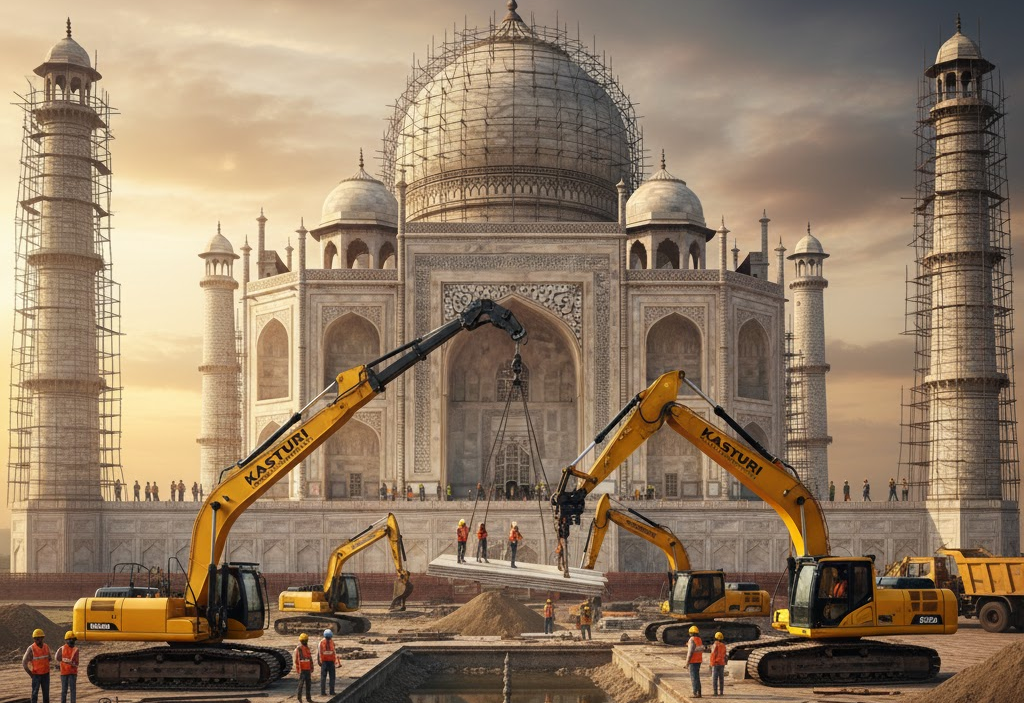The Taj Mahal has been the crown jewel of India ever since its construction was completed in the year 1653. It took more than 20,000 artisans, labourers and workers, working over the course of 22 years to finish what they started. The 17th-century masterpiece has thus been an epitome of the craftsmanship of the time.
But what if modern machinery, especially excavators, had been around at the time? What were the roles they could play? How could they have helped in the completion of the monument?
Let’s find it in the blog below.
The Role Excavators Could Have Played.
Imagine how the Taj Mahal’s construction site would’ve looked.
- Labourers digging the foundations, carrying all the dug-up soil, stones and stones on their backs.
- Central Asian sculptors, South Indian designers, Baloch stone cutters and Italian artists working for countless hours.
- Marble, red sandstone and many other precious stones are being brought in from Rajasthan, Fatehpur Sikri and many other parts of the world on horse carriages.
Now, what if an excavator drives into the scene?
- It would’ve helped Ustad Ahmad Lahori, the chief architect of the Taj Mahal, in completing excavation and land grading with exact and precise dimensions.
- All the dug-up soil, rocks would’ve been hauled away from the site and handled material.
- It would’ve helped lift and transport all the marble, red sandstone and other precious stones to the site.
As a result of this, the excavator would have saved countless hours in manual labour, saved costs and helped thousands of labourers in their work.
How Excavators Would Have Changed the Game
In the above section, we discussed the role excavators could’ve played. However, what we have not discussed is the ability of excavators to fundamentally change the game.
Digging the Foundations: A deep and precise foundation that would’ve taken months if not years could only be completed in days with the help of excavators.
Material Handling: Have you seen domesticated animals like elephants, horses and bulls hauling material? How much time do you think it would take a marble slab to be transported from Jaipur to Agra? The answer: An excavator with its hydraulic arms replacing elephants and horses would have dramatically reduced timelines in the construction of the Taj Mahal.
Reduced Labour and Associated Risks: Almost 20,000 labourers worked countless hours to build the great monument and make it what it is today. An excavator would have reduced labour costs by performing half the tasks these workers would have and the backbreaking and hazardous risks these labourers faced.
The Taj Mahal – Would It Still Be as Beautiful?
But, if modern excavators stepped in and helped build this marvellous monument, would it lose its beauty?
All the beautiful artistry, the marble carvings, the calligraphy and the inlay works make the Taj Mahal what it is known for today. That artistry is elegant. Modern machines can never replace the level of intricacy and detail that the artists of those times put in. These points towards the importance of humanity in the process of innovation and infrastructure development
Even if technology helps us build faster, humans still design, ideate and envision beauty. It is they who hold the key to building these marvels. Excavators will help, but they will only help when an excavator is driven by an operator. An operator applies his mind when performing excavation, trenching, demolition and grading tasks.
Lessons for Today
With the advent of modern excavators and earthmoving equipment, construction and infrastructure development have seen a monumental shift in terms of innovation, quality, reduced timelines and project efficiency. Although this has improved craftsmanship, it has failed to replace the genuine creative hunger of the human mind.
Excavators with their advanced technology represent the progress, innovation, and efficiency with which human life has developed. They are the perfect examples of human ingenuity and vision, just as the Taj Mahal is. The great monument represents the greatest vision, legacy and passion that humanity has ever possessed.
However, today’s modern infrastructure marvels like the Burj Khalifa, which is the tallest skyscraper in the world, or the Bandra-Worli Sea Link rely on the same spirit of excellence that is an integral part of the Taj Mahal. The only key aspect that differentiates them is that they were built faster and more safely.
To Conclude
If excavators had existed in the 17th century, the Taj Mahal might have been built in years instead of decades. The foundations would have been dug with precision, the marble lifted effortlessly, and the domes aligned with accuracy.
The Taj Mahal isn’t just a monument of marble; it’s a monument of devotion, patience, and human artistry. While modern excavators symbolise power, efficiency, and progress, the human touch behind every carved lotus and engraved verse reminds us that machines build structures.
Contact Us to Hire Our Excavator Rental Services
Kasturi Earthmovers
Call / WhatsApp: +91 9999 12 4242
Email: info@kasturiearthmovers.com
Address: 1215 Gera’s Imperium Rise, Hinjewadi Phase II, Pune – 411057

